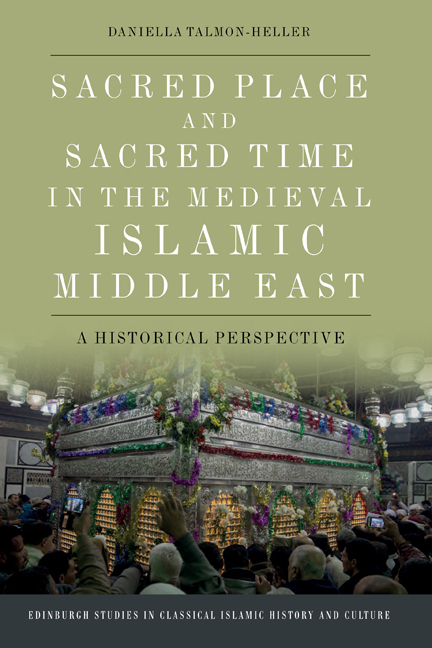Book contents
- Frontmatter
- Contents
- List of Figures
- Acknowledgements
- Map of the Middle East
- Introduction
- 1 Etic Concepts and Emic Terms
- 2 The State of the Art
- Part One A Sacred Place: The Shrine of al-Husayn’s Head
- Part Two A Sacred Time: The Month of Rajab
- Final Comments: Spacial and Temporal Sanctity
- Works Cited
- Index
21 - Summary
Published online by Cambridge University Press: 17 October 2020
- Frontmatter
- Contents
- List of Figures
- Acknowledgements
- Map of the Middle East
- Introduction
- 1 Etic Concepts and Emic Terms
- 2 The State of the Art
- Part One A Sacred Place: The Shrine of al-Husayn’s Head
- Part Two A Sacred Time: The Month of Rajab
- Final Comments: Spacial and Temporal Sanctity
- Works Cited
- Index
Summary
Rajab was celebrated on the Arab Peninsula before the rise of Islam, as one of four sacred months of travel to fairs and pilgrimage to shrines. Resort to arms was considered taboo during these periods. Some early Islamic authorities assert that Islam has only enhanced Rajab's merit, while others claimed that the month's veneration was terminated by the Prophet Muhammad. The debate remained unsettled for centuries (and carries on today on multiple websites). Undeterred, Muslims of all classes developped many and manifold creative ways, formal and informal, private and public, to continuously sanctify Rajab, adapting to changing historical contexts.
With the repeal of intercalation and the transition to the hijri calendar, Rajab lost its connection to the springtime festivities of Arabia. The ban against warfare during the four holy months, which was tied to the region's pagan sacred enclaves and their pilgrimage routes, as well as to the pre-Islamic socio-economic order, had also lost its force. Rajab visits to the sites of fairs in Arabia seem to have persisted for several generations and then faded away. The Rajab visitation of Mecca (known as ʿumra) persevered, supported by ruling authorities. Most of our early source material, however, appears to refer to individual or familial rites, such as fasting, domestic ritual slaughter, iʿtikāf in mosques, supererogatory prayer and invocation.
The terminus post quem of the formal public commemoration of Rajab in Egypt and in Northern Syria seems to fall into the first half of the tenth century, when the Fridays of the month were marked by special sermons in the presence of the ruler. The Fatimids, who wrested control over Egypt in 358/969 and transferred their seat of government to their newly established ‘ritual city’ al-Qāhira in 362/973, celebrated Rajab on a whole new scale. They developped a new repertoire of public rituals and state festivals, with a distinct Ismaʿili imperial flavor. Rajab became an occasion for displaying the imam-caliph's power and generosity to all his subjects on the one hand, while on the other hand promoting his veneration as the supreme walī-Allāh (friend of God) for the initiated Ismaʿili elite.
- Type
- Chapter
- Information
- Sacred Place and Sacred Time in the Medieval Islamic Middle EastA Historical Perspective, pp. 221 - 226Publisher: Edinburgh University PressPrint publication year: 2020



